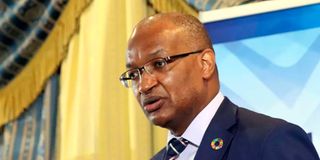CBK raises alarm on increased parastatal loans

Central Bank of Kenya Governor Patrick Njoroge.
The Central Bank of Kenya (CBK) has raised the alarm over increased borrowing of billions of shillings by parastatals to pay salaries, wages and other operational expenses weakening their ability to repay the loans.
Most state-owned enterprises (SOEs) remain highly indebted, worsened by persistent losses or thin profits that have hit them with liquidity challenges. This has forced them to resort to borrowing or bank overdrafts to carry out their daily operations.
CBK notes the financial situation of parastatals has been worsened by the shocks of the Covid-19 pandemic, legacy problems, competition from cheaper imports and weak governance that continues to weigh down recovery and viability of SOEs.
CBK said the accumulation of long-term debt by parastatals relative to equity increased from 134.2 per cent in 2020 to 135.3 per cent in 2021, placing them at a greater risk of defaulting on their loans.
“The SOEs therefore used long term debt to finance operational expenses rather than for investments to generate revenues to service future debt. This limits productivity, capacity, and profitability of SOEs, and in turn their viability,” said CBK.
Significant risk to the budget
State entities have for long posed a significant risk to the budget due to their heavy borrowing of both publicly guaranteed and non-guaranteed debt which is shouldered by taxpayers whenever they fail to repay.
By the end of June last year, parastatals had accumulated Sh157.22 billion of government-guaranteed debt.
Meanwhile, nine state entities alone had accumulated Sh104.84 billion of non-guaranteed debt.
More than half (Sh53.8 billion) was borrowed by Kenya Power, Sh19 billion by the Kenya Pipeline Company (KPC) and Sh13.6 billion by KenGen. Others are the Jomo Kenyatta University (Sh2.7 billion), East African Portland Cement (Sh1.7 billion) and Kenyatta University (Sh1.2 billion).
But what will worry taxpayers is that 88.7 per cent of this debt is due for payment within less than ten years, which means the creditors could come any time calling even as many of the parastatals continue to make huge losses.
Recurrent spending
This despite the loans being used for recurrent spending which does not help the firms address the inefficiencies — instead of investing in viable development projects that will ensure they become profitable to become self-reliant.
The CBK says the SOEs’ reliance on state bailouts is unsustainable.
“Reliance on fiscal support by SOEs is no longer viable due to declining fiscal space. Hence the need to increase efficiency and profitability,” said CBK.
The government has identified Kenya Power and national carrier Kenya Airways (KQ) as the two parastatals that pose the highest fiscal risk to the government due to their huge debt.
The National Treasury last year said the largest 18 parastatals need Sh383 billion in financial support over the next five years, which it aimed to cover through drastic cost-saving reforms at the firms.
IMF reforms
The International Monetary Fund has been pushing for reforms at the state entities as part of its 38-month loan agreement with Kenya to relieve the state of the burden of constantly bailing out the firms.
The pressures by the pandemic have compounded pre-existing structural weaknesses in the SOEs sector, including overlapping mandates, poor financial performance and weak governance.
Most of the parastatals such as Kenya Power and KQ are mismanaged, while others such as the Postal Corporation of Kenya no longer play an integral role to the economy and have failed to adapt and change to fit the modern age.





